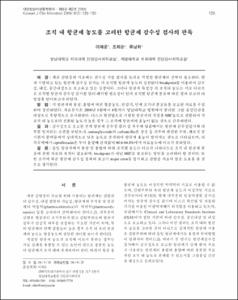KUMEL Repository
1. Journal Papers (연구논문)
1. School of Medicine (의과대학)
Dept. of Laboratory Medicine (진단검사의학)
조직 내 항균제 농도를 고려한 항균제 감수성 검사의 판독
- Keimyung Author(s)
- Ryoo, Nam Hee
- Department
- Dept. of Laboratory Medicine (진단검사의학)
- Journal Title
- 대한임상미생물학회지
- Issued Date
- 2006
- Volume
- 9
- Issue
- 2
- Keyword
- Antimicrobial concentration; Tissue level; Antibiotic susceptibility test; Minimum inhibitory concentration
- Abstract
- Background: For an optimum treatment of infections, appropriate antimicrobials should be
selected according to the results of antibiotic susceptibility test (AST). However, the present AST
does not take into account of antimicrobial concentrations in tissues, although different tissues have
different distribution of antimicrobials. Thereby we intended to evaluate the usefulness of
interpreting antimicrobial susceptibility depending on tissue concentrations of antimicrobials.
Methods: Gram-negative bacilli isolated from clinical specimens at Yeungnam University Hospital
during the period from January to July, 2006 were evaluated retrospectively. The data on blood
concentration, half life and tissue distribution of antimicrobials with variable administration route and
dosage were collected and arranged in the forms of previous reports. The diameters of the zone of
inhibition from the disc diffusion method were converted to minimum inhibitory concentration (MIC)
and the organism was regarded as resistant if the converted concentration was higher than the
expected concentration in the tissue.
Results: Among the data reported as susceptible, antimicrobial concentrations in peritoneal fluid
and bile showed a relatively good relationship with AST. But, aminoglycosides and carbenicllin
concentrations in wounds and respiratory tissues were shown to be inadequate, thus resulting in a
low bacteriologic cure. In cerebrospinal fluid, ciprofloxacin was less effective regardless of dosage.
Conclusion: Antimicrobial concentration is variable in different tissues and more information on
antimicrobial tissue distribution is needed for the appropriate treatment of infections. Reporting of
MIC rather than AST with breakpoints should be considered for selection of antimicrobials.
Therefore, an interpretation of AST in consideration of the tissue concentration would be more
helpful for prevention of major errors and control of infections.
배경:세균 감염증의 치료에는 감수성 시험 결과를 토대로 적절한 항균제의 선택이 필요하다. 현
재 시행되고 있는 항균제 감수성 검사는 각 조직별 항균제 농도와 상관없이 breakpoint를 이용하여 감수
성, 내성, 중간내성으로 보고하고 있는 실정이다. 그러나 항균제 특성상 각 조직의 농도는 서로 다르므
로 조직별 항균제 감수성 검사를 달리 해석할 필요성이 있어 조직별 항균제 분포에 따른 결과 보고의 타
당성을 알아보고자 하였다.
방배법:각 항균제의 용량, 용법에 따른 혈중농도, 반감기, 인체 조직내 분포들을 보고된 자료를 수집
하여 정리하였다. 자료분석은 2006년 1월에서 6월까지 영남대학교 병원에서 분리된 그람 음성간균을
대상으로 후향적으로 조사하였다. 디스크 확산법으로 시행한 항균제의 직경을 MIC농도로 전환하여 각
조직 내 농도보다 전환된 농도가 높은 경우 그 조직에 항균제의 효능이 없는 것으로 간주하였다.
결배과:감수성으로 보고된 전체 항균제 감수성 결과 중 복수와 답즙에서는 항균제 감수성검사와 대
부분 일치하는 소견을 보였으나, aminoglycoside와 carbenicllin은 창상 등 피부에 관련된 부위, 폐조직 및
기관지 분비물에서 상대적으로 낮은 농도로 존재하여 항균제 효능이 떨어지는 것으로 나타났으며, 뇌
척수액에서 ciprofloxacin은 투여 용량에 관계없이 60.6-64.8%에서 치료농도에 이르지 못하였다.
결배론:동일 항균제에서 용량 및 용법에 따라 조직별 농도는 다르게 나타나므로 조직 내 항균제 분
포에 관한 자료의 축적이 필요하며, breakpoint가 아닌 MIC로 보고하는 방안을 고려해야 할 것이다. 또
한 조직에 따른 항균제 감수성 결과의 보고가 major error를 방지하고 감염증 치료에 많은 도움을 줄 것
으로 생각된다.
- Alternative Title
- Interpretation of Susceptibility Tests in Consideration of Tissue Concentrations of Antimicrobials
- Keimyung Author(s)(Kor)
- 류남희
- Publisher
- School of Medicine
- Citation
- 이채훈 et al. (2006). 조직 내 항균제 농도를 고려한 항균제 감수성 검사의 판독. 대한임상미생물학회지, 9(2), 125–130.
- Type
- Article
- ISSN
- 1229-0025
- Appears in Collections:
- 1. School of Medicine (의과대학) > Dept. of Laboratory Medicine (진단검사의학)
- 파일 목록
-
-
Download
 oak-bbb-3394.pdf
기타 데이터 / 166.64 kB / Adobe PDF
oak-bbb-3394.pdf
기타 데이터 / 166.64 kB / Adobe PDF
-
Items in Repository are protected by copyright, with all rights reserved, unless otherwise indicated.